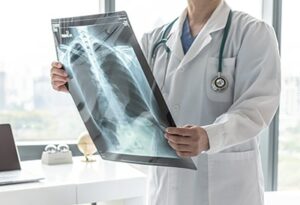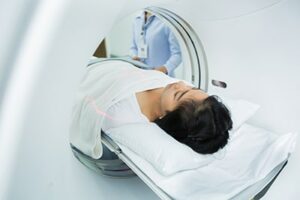Navigating Medical Imaging: Understanding the Differences Between X-Rays, CT Scans, and MRIs
Medical imaging has revolutionized the field of healthcare, enabling professionals to peer inside the human body with unprecedented clarity. Three commonly used imaging techniques—X-Rays, CT Scans, and MRIs—play crucial roles in diagnosing and treating a wide range of medical conditions.
In this article, we delve into the key differences between these imaging modalities, shedding light on their unique characteristics and applications. At Victoria ER, we’re proud to provide state-of-the-art imaging and lab capabilities.
X-Rays: The Pioneers of Imaging
X-Rays are the oldest and most widely recognized form of medical imaging. They use electromagnetic radiation to create two-dimensional images of the body’s internal structures. X-Rays are particularly useful for capturing dense structures like bones, making them ideal for detecting fractures, joint dislocations, and dental issues. However, X-Rays have limitations in visualizing soft tissues and may not provide detailed information on organs or blood vessels.
CT Scans: Cross-Sectional Precision
Computed Tomography (CT) Scans, often referred to as CAT Scans, take medical imaging to the next level by providing detailed cross-sectional images of the body. CT Scanners use a series of X-Rays taken from different angles to create a three-dimensional image. This modality excels in visualizing soft tissues, organs, and blood vessels, making it a valuable tool for detecting tumors, internal bleeding, and assessing the extent of trauma. CT Scans are widely employed in emergency situations due to their speed and versatility.
MRIs: Magnetic Resonance Imaging
Magnetic Resonance Imaging (MRI) employs a different approach, using strong magnetic fields and radio waves to generate detailed images of the body’s internal structures. MRIs excel in capturing soft tissues, such as the brain, muscles, and organs. Unlike X-Rays and CT Scans, MRIs do not involve ionizing radiation, making them a safer option for repeated imaging. MRIs are particularly valuable for diagnosing neurological conditions, joint and musculoskeletal disorders, and assessing the health of organs like the heart.
Key Differences
Radiation Exposure: X-Rays and CT Scans involve ionizing radiation, which can carry some health risks, especially with repeated exposure. MRIs, on the other hand, use non-ionizing radiation, making them safer for certain populations, such as pregnant women.
While X-Rays are best suited for imaging bones, CT Scans and MRIs offer superior visualization of soft tissues. CT Scans are proficient in capturing cross-sectional images, while MRIs provide detailed images of soft organs and structures.
X-Rays are quick and widely available. CT Scans, known for their speed, are often used in emergency settings. MRIs, although slower, provide unparalleled detail in soft tissue imaging.
CT Scans and MRIs may use contrast agents to enhance the visibility of specific structures. CT contrast is typically iodine-based, while MRI contrast involves gadolinium. The choice depends on the imaging goals and the patient’s health considerations.
In the realm of medical imaging, each modality—X-Rays, CT Scans, and MRIs—serves a distinct purpose, offering healthcare professionals valuable tools for accurate diagnosis and treatment planning. Understanding the differences between these imaging techniques empowers both healthcare providers and patients, ensuring that the most appropriate and effective imaging method is chosen based on individual medical needs. As technology continues to advance, the field of medical imaging evolves, providing ever-improving diagnostic capabilities and contributing to better patient outcomes.
Whether your specific condition requires an X-Ray or CT Scan, you can rest easy knowing that the medical professionals of Victoria ER are here for you! We’re readily available 24/7, and you’re not required to schedule an appointment.
Don’t risk or delay your health—visit Victoria ER!





 2. Exercise regularly. Physical activity can help boost immunity by stimulating the production of immune-boosting white blood cells. Moreover, regular exercise helps to rid the body of bacteria that can lead to illness and inflammation. Additionally, physical activity can stimulate immune-supporting hormones which will help protect against infection and disease. Get out there and get moving – it’s the best way to bolster your immune system!
2. Exercise regularly. Physical activity can help boost immunity by stimulating the production of immune-boosting white blood cells. Moreover, regular exercise helps to rid the body of bacteria that can lead to illness and inflammation. Additionally, physical activity can stimulate immune-supporting hormones which will help protect against infection and disease. Get out there and get moving – it’s the best way to bolster your immune system! 4. Manage stress levels. Stress is known to weaken the immune system, making people more vulnerable to illness, so by reducing and managing your stress levels, we can help keep your immune system in top condition. There are many different methods for managing stress such as yoga, exercise, journaling or even simply taking time each day to relax and practice mindfulness. Focusing on improving your capacity to handle stress can be a great way of helping yourself stay healthy this winter season.
4. Manage stress levels. Stress is known to weaken the immune system, making people more vulnerable to illness, so by reducing and managing your stress levels, we can help keep your immune system in top condition. There are many different methods for managing stress such as yoga, exercise, journaling or even simply taking time each day to relax and practice mindfulness. Focusing on improving your capacity to handle stress can be a great way of helping yourself stay healthy this winter season. 6. Boost immune system health with immune-boosting supplements. To make sure that you can fight off any unwanted viruses, it’s important to supplement your immune system with immune-boosting supplements. These supplements are easy to take in either pill or liquid form and contain immune-supporting vitamins and minerals that are essential for immune health. Not only do these supplements reduce the risk of getting sick, but they also give you the energy you need to keep up with your daily routine.
6. Boost immune system health with immune-boosting supplements. To make sure that you can fight off any unwanted viruses, it’s important to supplement your immune system with immune-boosting supplements. These supplements are easy to take in either pill or liquid form and contain immune-supporting vitamins and minerals that are essential for immune health. Not only do these supplements reduce the risk of getting sick, but they also give you the energy you need to keep up with your daily routine.
 Here’s a quick breakdown of each.
Here’s a quick breakdown of each. 



 deadly allergy to bee stings), but what about cockroaches? This common pest can cause asthma attacks. Dust mites, mosquitoes, bed bugs, and other common bugs can also cause redness, itchiness, and swelling.
deadly allergy to bee stings), but what about cockroaches? This common pest can cause asthma attacks. Dust mites, mosquitoes, bed bugs, and other common bugs can also cause redness, itchiness, and swelling.
 Being a parent is hard, right? Let’s admit that and get it out of the way now. Regardless of age—infant, toddler, preschooler, teen, young adult—you never stop worrying about your child. That being said, it’s possible that the younger years are the most difficult. When you have a baby on your hands, you want to bubble wrap them, ensuring nothing bad happens.
Being a parent is hard, right? Let’s admit that and get it out of the way now. Regardless of age—infant, toddler, preschooler, teen, young adult—you never stop worrying about your child. That being said, it’s possible that the younger years are the most difficult. When you have a baby on your hands, you want to bubble wrap them, ensuring nothing bad happens. That being said, again, accidents can and do occur, so it’s necessary to be prepared.
That being said, again, accidents can and do occur, so it’s necessary to be prepared. If your baby starts to demonstrate any of these signs, especially if he or she goes into a seizure, take action right away—without hesitation. Remember, safety comes first! As such, either drive your child to the nearest emergency room or call 9-1-1. If you can, bring the medication your baby swallowed to the hospital, as this will allow the doctors to better assess the situation and establish an accurate treatment plan for your child.
If your baby starts to demonstrate any of these signs, especially if he or she goes into a seizure, take action right away—without hesitation. Remember, safety comes first! As such, either drive your child to the nearest emergency room or call 9-1-1. If you can, bring the medication your baby swallowed to the hospital, as this will allow the doctors to better assess the situation and establish an accurate treatment plan for your child.
 For X-Rays, we currently use the Del Medical brand and SHF-535 model.
X-Rays are beneficial to examine most areas of the body, particularly bones and joints. However, an X-Ray can also detect issues affecting soft tissue.
X-Rays allow our medical team to view what is happening inside your body without making an incision. Then, we can effectively diagnose, monitor, and treat the medical condition we discover. Of course, different types of X-Rays are necessary for different purposes.
There are myriad reasons why you could require an X-Ray, such as:
For X-Rays, we currently use the Del Medical brand and SHF-535 model.
X-Rays are beneficial to examine most areas of the body, particularly bones and joints. However, an X-Ray can also detect issues affecting soft tissue.
X-Rays allow our medical team to view what is happening inside your body without making an incision. Then, we can effectively diagnose, monitor, and treat the medical condition we discover. Of course, different types of X-Rays are necessary for different purposes.
There are myriad reasons why you could require an X-Ray, such as:
 For CT Scans, we currently use the 16 Slice brand and 2269165-3 model.
Specifically, a CT Scan is a diagnostic imaging procedure that uses both X-Rays and computer technology to produce images of the inside of the body. A low dose of radiation is present in CT Scans, but no long-term damage has been known to occur. In fact, the numerous benefits of a CT Scan greatly outweigh any potential risk.
This tool can show us detailed images of any part of the body, such as the following:
For CT Scans, we currently use the 16 Slice brand and 2269165-3 model.
Specifically, a CT Scan is a diagnostic imaging procedure that uses both X-Rays and computer technology to produce images of the inside of the body. A low dose of radiation is present in CT Scans, but no long-term damage has been known to occur. In fact, the numerous benefits of a CT Scan greatly outweigh any potential risk.
This tool can show us detailed images of any part of the body, such as the following:
 For bedside Ultrasounds, we currently use the Mindray brand and UMT-300 model.
This is a very particular type of Ultrasound Scan that we perform to answer questions in real time about your body. Ultrasounds are accurate, non-invasive, and require no radiation. They use sound waves to produce images of structures within the body. These images can—and do—provide the information needed to diagnose and treat various diseases and medical conditions. Better yet, bedside Ultrasounds can work faster than a CT Scan.
Bedside Ultrasounds are often used to:
For bedside Ultrasounds, we currently use the Mindray brand and UMT-300 model.
This is a very particular type of Ultrasound Scan that we perform to answer questions in real time about your body. Ultrasounds are accurate, non-invasive, and require no radiation. They use sound waves to produce images of structures within the body. These images can—and do—provide the information needed to diagnose and treat various diseases and medical conditions. Better yet, bedside Ultrasounds can work faster than a CT Scan.
Bedside Ultrasounds are often used to:
